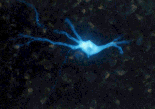

|
||||
| Sponsored by Wake Forest University School of Medicine and National Families in Action | ||||
|
||||
Rat Study Shows Link Between Stress and Relapse to Drug Abuse |
||||
A recent NIDA study builds upon previous research findings into the relationship between stress and drug abuse, by identifying a direct link between stress- and reward-associated mechanisms in the brains of rats. Dr. Roy Wise, of the National Institute on Drug Abuse, and colleagues from Tufts University and the University of Pennsylvania School of Medicine examined the effects of stress in adult male rats exposed to cocaine. The rats were trained to self-administer cocaine or saline (controls) and then subjected to withdrawal. Following training and withdrawal, the rats were exposed to a series of footshocks. The scientists then tested for the presence of stress-related chemicals in the brains of cocaine-exposed and control rats. Researchers found that both cocaine-exposed and control rats had increased levels of the stress-related compound corticotropin-releasing factor (CRF) in the ventral tegmental area (VTA), a region of the brain associated with pleasure. Moreover, the presence of stress compound in the VTA was found to trigger a relapse to drug-seeking behavior by the cocaine-exposed rats. |
The scientists published their findings in the June 1, 2005 issue of the Journal of Neuroscience. NIDA NewsScan, February 1, 2006 |
|||
EEG Shown to Reliably Predict Drug and Alcohol Relapse Potential |
||||
A University of Connecticut School of Medicine researcher has found that use of quantitative electroencephalography (EEG) is a reliable tool to predict which patients with histories of abuse of alcohol,cocaine, cocaine and alcohol, or opioid dependence are prone to relapse. EEGs were given to 107 substance-dependent patients enrolled in a treatment program and to 22 controls with no history of substance abuse. An electroencephalogram was administered when the patients had been free of alcohol or drug use for an average of 3 months. The patients were then monitored for the next 6 months to see if they resumed alcohol or drug use. The researcher observed that the 48 patients who relapsed to substance abuse shared a similar characteristic – their EEGs showed an increased amount of high-frequency activity, compared to the 59 patients who maintained abstinence and to the 22 control subjects. This high-frequency activity on the EEGs was found to far outweigh |
clinical and demographic variables as a predictor of relapse.
The study by Dr. Lance Bauer, Professor of Psychiatry and Director of the Neural Dynamics Laboratory at the University of Connecticut, was published in the July 2001 issue of the journal Neuropsychopharmacology. NIDA NewsScan, October 16, 2001 |
|||
| Progress Made in Understanding Neurobiological Basis for Relapse to Cocaine Abuse |
||||
| Researchers from the Albert Einstein College of Medicine and NIDA’s Intramural Research Program have made a major advance in understanding the neurobiological basis for cocaine abuse relapse. It had been known previously that the learning of associations betweenenvironmental cues and taking drugs occurs in the hippocampus and that these cues are a major cause of relapse to drug-taking behavior. Now scientists have pinpointed the region (the ventral subiculum area) of the hippocampus and the neurobiological factors (glutamateneurotransmission) that may play an integral role in cocaine abuse relapse. To arrive at these findings, the researchers first conditioned rats to obtain cocaine by pushing a lever (cocaine-seeking behavior). After this behavior had been well established, saline solution was substituted for cocaine. When the rats no longer received cocaine bypushing the lever, they greatly |
decreased their lever pushing. The investigators electrically stimulated and injected pharmacological compounds into rats’ brains to regenerate cocaine-seeking behavior, and then mapped those brain areas involved in the animals’ revived interest in seeking the drug (as measured by increased lever pushing).
The study is published by lead investigator Dr. Stanislav R. Vorel in the May 11, 2001, issue of Science. It is available online at the journal’s Web site www.sciencemag.org. NIDA NewsScan, May 21, 2001 |
|||
| |
||||
| Home | For Journalists | For the States | Science Update | Links | Glossary | About |
Last Revision
info@addictionstudies.org